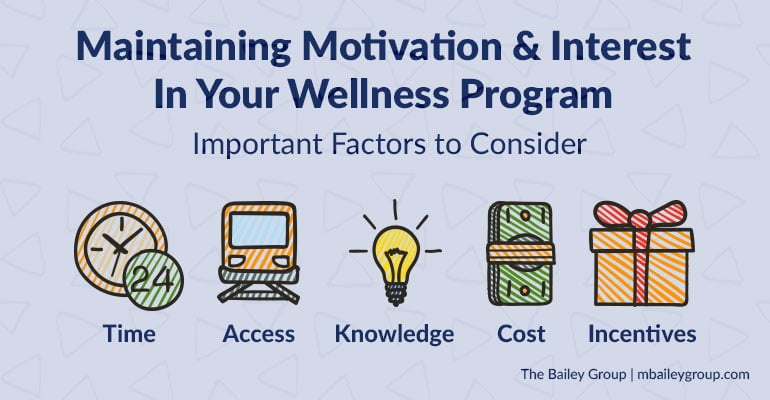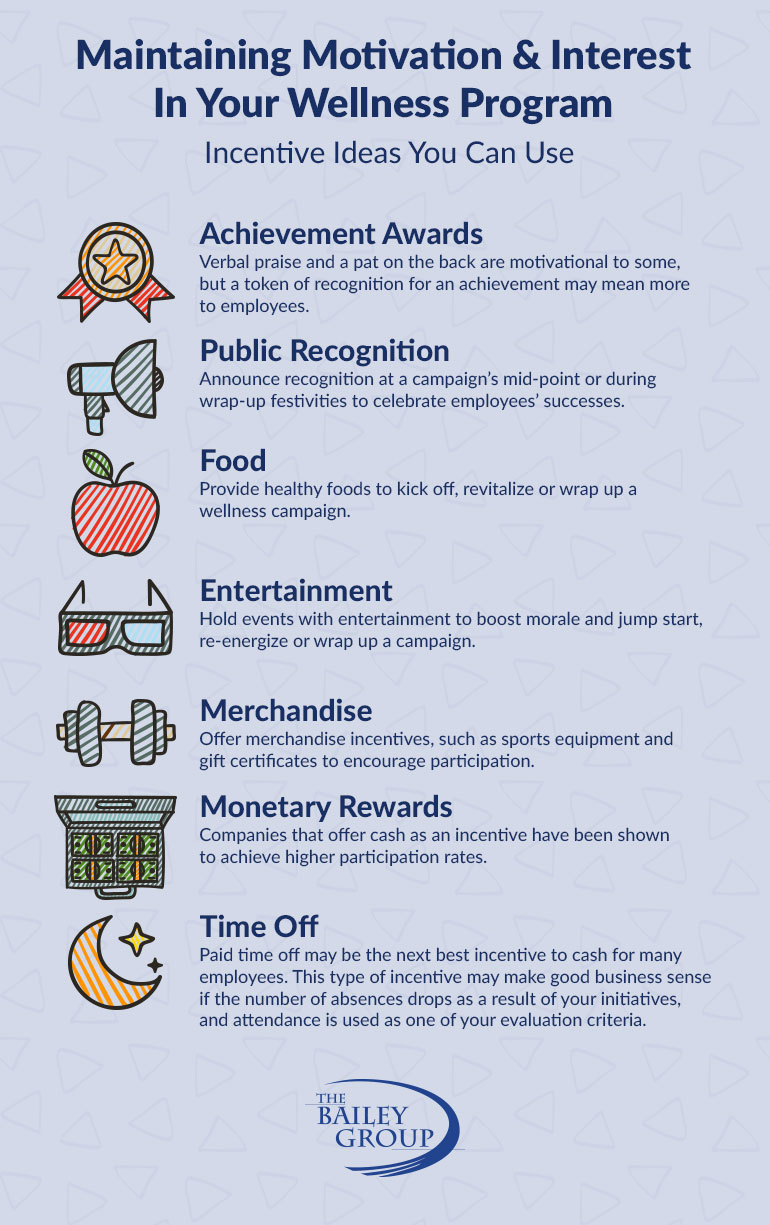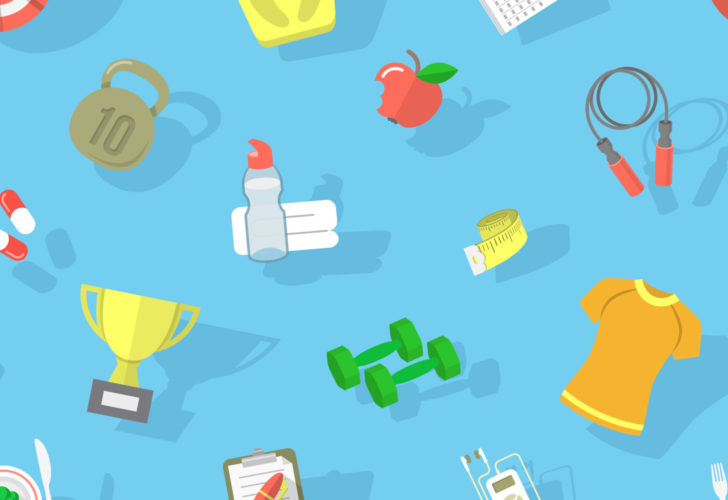3 Keys to Maintaining Motivation and Interest In Your Wellness Program
By The Bailey Group Marketing
Published March 22, 2017

Garnering interest in your company’s wellness program normally isn’t too tall a task as your employees will naturally have various levels of interest in your health promotion offerings from the jump.
Maintaining motivation and participation in your wellness program is a totally different story.
While some of your employees may already be active and eating well, others may be more difficult to engage. Below are some tips you can use to gain long-term employee buy-in once your program is up and running.

Some Important Factors to Consider
The following items can influence the likelihood of employees participating in your wellness program.
- Time – People are busy, so the more you can work activity and healthy eating into their existing schedules, the better your chances are for success. For example, if it’s nice out, consider having a walk-and-talk meeting instead of a sit-down meeting in order to sneak more activity in during the day. In addition, look at the time of the day and length of any activity you might be promoting. Employees may be more inclined to participate over lunch or at the end of the day than in the morning, for instance.
- Access – How accessible are your programs? Are they on-site or at a nearby facility? If employees have to travel far or the location is difficult to get to, employees may be less inclined to participate.
- Knowledge – People need to know the benefits of the program and need instructions and education on adopting healthier habits and behaviors.
- Cost – Providing free or reduced-cost programs can increase participation.
- Incentives – Some companies have found success in offering employees rewards for participating in a wellness program or for meeting certain health goals.
1. Know the Key Time Periods For Your Wellness Program
Good habits are often difficult to develop. The following are key time periods during a wellness initiative:
- First six weeks – The first few weeks are a critical time when many employees drop out of an exercise or diet program. If people can stay with a program for six weeks, they have made a serious commitment to incorporate healthy habits into their lifestyles.
- First six months – Employees who made it past six weeks may get distracted or bored with the program after several months. Keeping employees’ interest during this time is critical.
- First year – If employees can sustain the behavior for a full year, they have a very good chance of making the healthy lifestyle change permanent.
Consider these time periods and think about how you can help your employees get past these critical time markers. Promoting individual or group challenges, using incentives and increasing awareness are a few things you can do to keep your employees interested in the program.
2. Set Concrete Goals
Setting clear goals can lead to better results. Whether it is a team goal of walking the equivalent of once around your state, or an individual goal of walking so many miles or clocking so minutes of an activity, having something concrete to aim for increases the likelihood that employees will stick with the program.
Buddy System or Team Goals
The social aspects of improving one’s health cannot be underestimated. Many studies point to tight social groups being the backbone of a successful campaign because each individual has a commitment to something bigger than themselves. Plus, team activities are often more fun for people. Consider building your program around teams or partners to get a better return on your investment.
Team Campaigns
An organization-wide campaign or competition can raise awareness for your wellness initiatives. Encourage campaign participation, but make it voluntary so that employees who prefer that type of motivation can join while others can participate in their own way and at their own pace.
3. Incentives Are a Powerful Tool

Incentives can help maintain or raise interest in wellness initiatives. Listed below are some sample incentives employers can offer:
- Achievement awards – Verbal praise and a pat on the back are motivational to some, but a token of recognition for an achievement may mean more to employees. A colorful certificate to congratulate an employee on achieving a health-related goal is one example.
- Public recognition – Announce recognition at a campaign’s mid-point or during wrap-up festivities to celebrate employees’ successes.
- Food – Provide healthy foods to kick off, revitalize or wrap up a wellness campaign.
- Entertainment – Hold events with entertainment to boost morale and jump start, re-energize or wrap up a campaign.
- Merchandise – Offer merchandise incentives, such as sports equipment and gift certificates to encourage participation.
- Monetary rewards – Companies that offer cash as an incentive have been shown to achieve higher participation rates.
- Time off – Paid time off may be the next best incentive to cash for many employees. This type of incentive may make good business sense if the number of absences drops as a result of your initiatives, and attendance is used as one of your evaluation criteria.
In addition, look at your benefits package to see if your insurance carrier covers any wellness components. For instance, if your carrier offers reimbursement for things like fitness classes or club memberships, promote them to your employees so they can take advantage of them.
By using these strategies, you can increase participation in your wellness program and build a healthier workforce for years to come.
Are you looking to get a wellness program off the ground at your company? Our Health Promotion team is here to help you create a best-in-class wellness program. Take a look at how we can help and then drop us a line at the bottom of the page. We’d love to have a conversation about how we can help you create a happier and healthier workforce.




